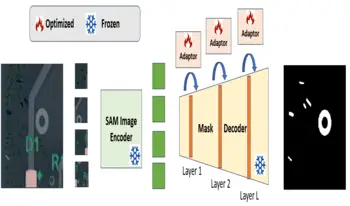
PCB defect segmentation aims to localize the defects in printed circuit boards (PCBs). While this problem has a great industrial impact, few datasets are publicly available. It is also challenging to predict the defects that appear during manufacturing. To address the former challenge, we curate a large dataset with various defective categories of imbalanced distribution, reflecting real-world conditions. The problem of unsupervised PCB anomaly segmentation (UAS), where no labeled defect data is available during training, is then investigated. We propose an efficient prompt tuning method to address PCB-UAS. Specifically, a pretrained large foundational segmentation model (SAM) is adapted to PCB-UAS by the introduction of a few learnable adapter layers. SAM is frozen during training and only the additional adapter parameters are learned. To overcome the lack of labeled defect images for training, we propose to create synthetic defect images that mimic the real ones. Experiments highlight that the proposed method can outperform baselines by 7 points with 16.6 times less learnable parameters.
Chih-Hui Ho, SungBal Seo, NaYeon Kim, Pin-Ying Wu, YouSuk Bae, Nuno Vasconcelos, "Unsupervised PCB Anomaly Segmentation with Foundational Models" in Electronic Imaging, 2024, pp 277-1 - 277-5, https://doi.org/10.2352/EI.2024.36.6.IRIACV-277
 Find this author on Google Scholar
Find this author on Google Scholar Find this author on PubMed
Find this author on PubMed